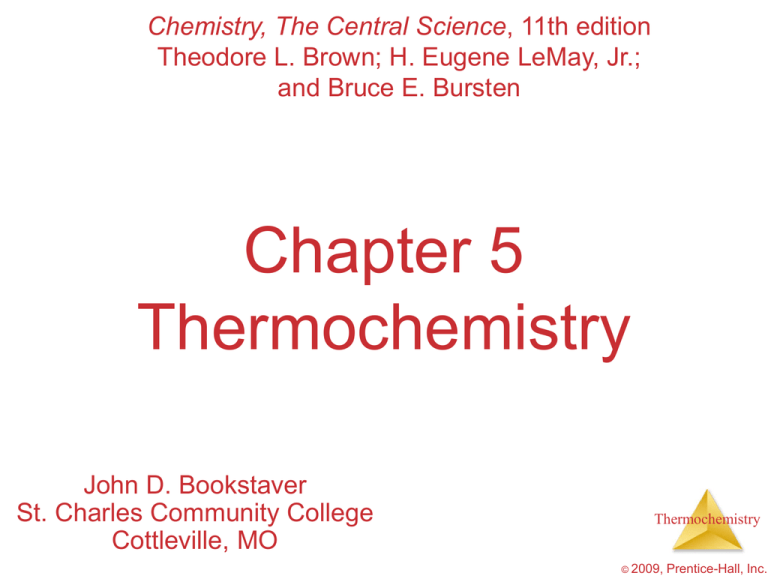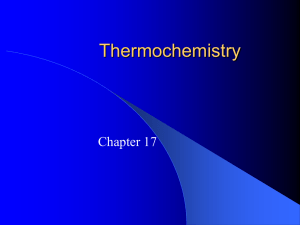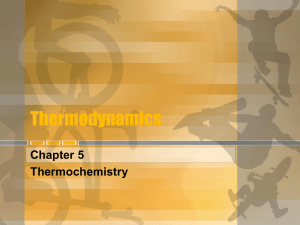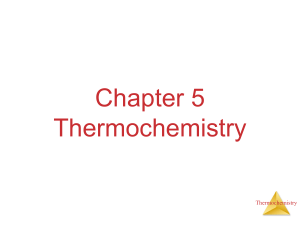g - Madison County Schools
advertisement

Chemistry, The Central Science, 11th edition Theodore L. Brown; H. Eugene LeMay, Jr.; and Bruce E. Bursten Chapter 5 Thermochemistry John D. Bookstaver St. Charles Community College Cottleville, MO Thermochemistry © 2009, Prentice-Hall, Inc. Energy • Energy is the ability to do work or transfer heat. – Energy used to cause an object that has mass to move is called work. – Energy used to cause the temperature of an object to rise is called heat. Thermochemistry © 2009, Prentice-Hall, Inc. Potential Energy Potential energy is energy an object possesses by virtue of its position or chemical composition. Thermochemistry © 2009, Prentice-Hall, Inc. Kinetic Energy Kinetic energy is energy an object possesses by virtue of its motion. 1 KE = mv2 2 Thermochemistry © 2009, Prentice-Hall, Inc. Units of Energy • The SI unit of energy is the joule (J). kg m2 1 J = 1 s2 • An older, non-SI unit is still in widespread use: the calorie (cal). 1 cal = 4.184 J Thermochemistry © 2009, Prentice-Hall, Inc. Definitions: System and Surroundings • The system includes the molecules we want to study (here, the hydrogen and oxygen molecules). • The surroundings are everything else (here, the cylinder and piston). Thermochemistry © 2009, Prentice-Hall, Inc. Definitions: Work • Energy used to move an object over some distance is work. • w=Fd where w is work, F is the force, and d is the distance over which the force is exerted. Thermochemistry © 2009, Prentice-Hall, Inc. Heat • Energy can also be transferred as heat. • Heat flows from warmer objects to cooler objects. Thermochemistry © 2009, Prentice-Hall, Inc. Conversion of Energy • Energy can be converted from one type to another. • For example, the cyclist above has potential energy as she sits on top of the hill. Thermochemistry © 2009, Prentice-Hall, Inc. Conversion of Energy • As she coasts down the hill, her potential energy is converted to kinetic energy. • At the bottom, all the potential energy she had at the top of the hill is now kinetic energy. Thermochemistry © 2009, Prentice-Hall, Inc. First Law of Thermodynamics • Energy is neither created nor destroyed. • In other words, the total energy of the universe is a constant; if the system loses energy, it must be gained by the surroundings, and vice versa. Thermochemistry © 2009, Prentice-Hall, Inc. Internal Energy The internal energy of a system is the sum of all kinetic and potential energies of all components of the system; we call it E. Thermochemistry © 2009, Prentice-Hall, Inc. Internal Energy By definition, the change in internal energy, E, is the final energy of the system minus the initial energy of the system: E = Efinal − Einitial Thermochemistry © 2009, Prentice-Hall, Inc. Changes in Internal Energy • If E > 0, Efinal > Einitial – Therefore, the system absorbed energy from the surroundings. – This energy change is called endergonic. Thermochemistry © 2009, Prentice-Hall, Inc. Changes in Internal Energy • If E < 0, Efinal < Einitial – Therefore, the system released energy to the surroundings. – This energy change is called exergonic. Thermochemistry © 2009, Prentice-Hall, Inc. Changes in Internal Energy • When energy is exchanged between the system and the surroundings, it is exchanged as either heat (q) or work (w). • That is, E = q + w. Thermochemistry © 2009, Prentice-Hall, Inc. E, q, w, and Their Signs Thermochemistry © 2009, Prentice-Hall, Inc. Exchange of Heat between System and Surroundings • When heat is absorbed by the system from the surroundings, the process is endothermic. Thermochemistry © 2009, Prentice-Hall, Inc. Exchange of Heat between System and Surroundings • When heat is absorbed by the system from the surroundings, the process is endothermic. • When heat is released by the system into the surroundings, the process is exothermic. Thermochemistry © 2009, Prentice-Hall, Inc. State Functions Usually we have no way of knowing the internal energy of a system; finding that value is simply too complex a problem. Thermochemistry © 2009, Prentice-Hall, Inc. State Functions • However, we do know that the internal energy of a system is independent of the path by which the system achieved that state. – In the system below, the water could have reached room temperature from either direction. Thermochemistry © 2009, Prentice-Hall, Inc. State Functions • Therefore, internal energy is a state function. • It depends only on the present state of the system, not on the path by which the system arrived at that state. • And so, E depends only on Einitial and Efinal. Thermochemistry © 2009, Prentice-Hall, Inc. State Functions • However, q and w are not state functions. • Whether the battery is shorted out or is discharged by running the fan, its E is the same. – But q and w are different in the two cases. Thermochemistry © 2009, Prentice-Hall, Inc. Work Usually in an open container the only work done is by a gas pushing on the surroundings (or by the surroundings pushing on the gas). Thermochemistry © 2009, Prentice-Hall, Inc. Work We can measure the work done by the gas if the reaction is done in a vessel that has been fitted with a piston. w = -PV Thermochemistry © 2009, Prentice-Hall, Inc. Enthalpy • If a process takes place at constant pressure (as the majority of processes we study do) and the only work done is this pressure-volume work, we can account for heat flow during the process by measuring the enthalpy of the system. • Enthalpy is the internal energy plus the product of pressure and volume: H = E + PV Thermochemistry © 2009, Prentice-Hall, Inc. Enthalpy • When the system changes at constant pressure, the change in enthalpy, H, is H = (E + PV) • This can be written H = E + PV Thermochemistry © 2009, Prentice-Hall, Inc. Enthalpy • Since E = q + w and w = -PV, we can substitute these into the enthalpy expression: H = E + PV H = (q+w) − w H = q • So, at constant pressure, the change in enthalpy is the heat gained or lost. Thermochemistry © 2009, Prentice-Hall, Inc. Endothermicity and Exothermicity • A process is endothermic when H is positive. Thermochemistry © 2009, Prentice-Hall, Inc. Endothermicity and Exothermicity • A process is endothermic when H is positive. • A process is exothermic when H is negative. Thermochemistry © 2009, Prentice-Hall, Inc. Enthalpy of Reaction The change in enthalpy, H, is the enthalpy of the products minus the enthalpy of the reactants: H = Hproducts − Hreactants Thermochemistry © 2009, Prentice-Hall, Inc. Enthalpy of Reaction This quantity, H, is called the enthalpy of reaction, or the heat of reaction. Thermochemistry © 2009, Prentice-Hall, Inc. The Truth about Enthalpy 1. Enthalpy is an extensive property. 2. H for a reaction in the forward direction is equal in size, but opposite in sign, to H for the reverse reaction. 3. H for a reaction depends on the state of the products and the state of the reactants. Thermochemistry © 2009, Prentice-Hall, Inc. A moving racquetball has __________ energy. 100% 0% 0% 0% 1. 2. 3. 4. kinetic potential work heat Thermochemistry A motionless racquetball has __________ energy. 0% 100% 0% 0% 1. 2. 3. 4. kinetic potential work heat Thermochemistry A racquetball player perspires during the game, giving off __________ energy. 6% 0% 13% 81% 1. 2. 3. 4. kinetic potential work heat Thermochemistry The sum of all the kinetic and potential energies of a system’s components is known as its: 0% 0% 100% 0% 1. 2. 3. 4. integral energy. dynamic energy. internal energy. work energy. Thermochemistry A system absorbs heat during an __________ process. 0% 0% 0% 100% 1. 2. 3. 4. exothermic isothermic adiabatic endothermic Thermochemistry Which of the following is NOT a state function? 10% 50% 0% 40% 1. 2. 3. 4. internal energy temperature enthalpy work Thermochemistry Calculation of Enthalpy Thermochemistry © 2009, Prentice-Hall, Inc. Stoichiometry • Ex. Upon adding solid potassium hydroxide pellets to water, the following reaction takes place KOH K+ + OH• For the reaction at constant pressure, ∆H=-43kJ/mol. When 14.0 g of KOH is added to water, – Is the reaction endothermic or exothermic? – Does the beaker get warmer or colder? Thermochemistry – What is the enthalpy change for the dissolution? 2009, Prentice-Hall, Inc. © For the reaction at constant pressure, ∆H=43kJ/mol. When 14.0 g of KOH is added to water, what is the enthalpy change for the dissolution? Thermochemistry © 2009, Prentice-Hall, Inc. Calorimetry Since we cannot know the exact enthalpy of the reactants and products, we measure H through calorimetry, the measurement of heat flow. Thermochemistry © 2009, Prentice-Hall, Inc. Heat Capacity and Specific Heat The amount of energy required to raise the temperature of a substance by 1 K (1C) is its heat capacity. Thermochemistry © 2009, Prentice-Hall, Inc. Heat Capacity and Specific Heat We define specific heat capacity (or simply specific heat) as the amount of energy required to raise the temperature of 1 g of a substance by 1 K. Thermochemistry © 2009, Prentice-Hall, Inc. Heat Capacity and Specific Heat Specific heat, then, is Specific heat = s= heat transferred mass temperature change q m T Thermochemistry © 2009, Prentice-Hall, Inc. Constant Pressure Calorimetry By carrying out a reaction in aqueous solution in a simple calorimeter such as this one, one can indirectly measure the heat change for the system by measuring the heat change for the water in the calorimeter. Thermochemistry © 2009, Prentice-Hall, Inc. Constant Pressure Calorimetry Because the specific heat for water is well known (4.184 J/g-K), we can measure H for the reaction with this equation: q = m s T Thermochemistry © 2009, Prentice-Hall, Inc. When a hot piece of metal is placed into cool water, energy: 100% 0% 0% 0% 1. 2. 3. 4. flows from the metal to the water. flows from the water to the metal. does not flow. is not conserved. Thermochemistry Which metal will undergo the greatest temperature change if an equal amount of heat is added to each? 0% 25% 0% 75% 0% 1. 2. 3. 4. 5. Fe, s = 0.45 J/g K Al, s = 0.90 J/g K Cu, s = 0.38 J/g K Pb, s = 0.13 J/g K Sn, s = 0.22 J/g K Thermochemistry % % % % % If a piece of metal at 85°C is added to water at 25°C, the final temperature of the system is 30°C. Which of the following is true? 1. Heat lost by the metal > heat gained by water. 2. Heat gained by water > heat lost by the metal. 3. Heat lost by metal > heat lost by the water. 4. Heat lost by the metal = heat gained by water. Thermochemistry 5. More information is required. Example problem – physical exchange • 2540 J is absorbed by 278 g of water at 21.4 oC. What is the final temperature of the system? Thermochemistry © 2009, Prentice-Hall, Inc. Another example – physical exchange • A piece of an unknown metal with mass 23.8 g is heated to 100.0 oC and dropped into 50.0 cm3 of water at 24.0 oC. The final temperature of the system is 32.5 oC. What is the specific heat of the metal? The specific heat of water is 4.18 J/goC. Thermochemistry © 2009, Prentice-Hall, Inc. Physical heat exchanges • The color of many ceramic glazes comes from cadmium compounds. If a piece of cadmium with mass 65.6 g and a temperature of 100.0 oC is dropped into 25.0 cm3 of water at 23.0 oC, what will be the final temperature of the system? Remember both the metal and water will end up at the same final temp. Thermochemistry © 2009, Prentice-Hall, Inc. Chemical Reactions and calorimetry – Sample problem Suppose you place 0.5 g of magnesium chips in a coffee-cup calorimeter and then add 100 mL of 1 M HCl. The temperature of the solution increases from 22.2C to 44.8C. What is the enthalpy change for this reaction per mole of Mg? (assume the heat capacity of the solution is 4.2 J/gK and the density of the HCl solution is 1 g/mL) Thermochemistry © 2009, Prentice-Hall, Inc. Bomb Calorimetry • Reactions can be carried out in a sealed “bomb” such as this one. • The heat absorbed (or released) by the water is a very good approximation of the enthalpy change for the reaction. Thermochemistry © 2009, Prentice-Hall, Inc. Bomb Calorimetry • Because the volume in the bomb calorimeter is constant, what is measured is really the change in internal energy, E, not H. • For most reactions, the difference is very small. Thermochemistry © 2009, Prentice-Hall, Inc. Thermochemistry © 2009, Prentice-Hall, Inc. Enthalpies of formation Thermochemistry © 2009, Prentice-Hall, Inc. Enthalpies of Formation An enthalpy of formation, Hf, is defined as the enthalpy change for the reaction in which a compound is made from its constituent elements in their elemental forms. Thermochemistry © 2009, Prentice-Hall, Inc. Standard Enthalpies of Formation Standard enthalpies of formation, Hf°, are measured under standard conditions (25 °C and 1.00 atm pressure). Thermochemistry © 2009, Prentice-Hall, Inc. Calculation of H C3H8 (g) + 5 O2 (g) 3 CO2 (g) + 4 H2O (l) • Imagine this as occurring in three steps: C3H8 (g) 3 C (graphite) + 4 H2 (g) 3 C (graphite) + 3 O2 (g) 3 CO2 (g) 4 H2 (g) + 2 O2 (g) 4 H2O (l) Thermochemistry © 2009, Prentice-Hall, Inc. Calculation of H C3H8 (g) + 5 O2 (g) 3 CO2 (g) + 4 H2O (l) • Imagine this as occurring in three steps: C3H8 (g) 3 C (graphite) + 4 H2 (g) 3 C (graphite) + 3 O2 (g) 3 CO2 (g) 4 H2 (g) + 2 O2 (g) 4 H2O (l) Thermochemistry © 2009, Prentice-Hall, Inc. Calculation of H C3H8 (g) + 5 O2 (g) 3 CO2 (g) + 4 H2O (l) • Imagine this as occurring in three steps: C3H8 (g) 3 C (graphite) + 4 H2 (g) 3 C (graphite) + 3 O2 (g) 3 CO2 (g) 4 H2 (g) + 2 O2 (g) 4 H2O (l) Thermochemistry © 2009, Prentice-Hall, Inc. Calculation of H C3H8 (g) + 5 O2 (g) 3 CO2 (g) + 4 H2O (l) • The sum of these equations is: C3H8 (g) 3 C (graphite) + 4 H2 (g) 3 C (graphite) + 3 O2 (g) 3 CO2 (g) 4 H2 (g) + 2 O2 (g) 4 H2O (l) C3H8 (g) + 5 O2 (g) 3 CO2 (g) + 4 H2O (l) Thermochemistry © 2009, Prentice-Hall, Inc. Calculation of H We can use Hess’s law in this way: H = nHf°products – mHf° reactants where n and m are the stoichiometric coefficients. Thermochemistry © 2009, Prentice-Hall, Inc. Calculation of H C3H8 (g) + 5 O2 (g) 3 CO2 (g) + 4 H2O (l) H = [3(-393.5 kJ) + 4(-285.8 kJ)] – [1(-103.85 kJ) + 5(0 kJ)] = [(-1180.5 kJ) + (-1143.2 kJ)] – [(-103.85 kJ) + (0 kJ)] = (-2323.7 kJ) – (-103.85 kJ) = -2219.9 kJ Thermochemistry © 2009, Prentice-Hall, Inc. Hess’s Law H is well known for many reactions, and it is inconvenient to measure H for every reaction in which we are interested. • However, we can estimate H using published H values and the properties of enthalpy. Thermochemistry © 2009, Prentice-Hall, Inc. Hess’s Law Hess’s law states that “[i]f a reaction is carried out in a series of steps, H for the overall reaction will be equal to the sum of the enthalpy changes for the individual steps.” Thermochemistry © 2009, Prentice-Hall, Inc. Hess’s Law Because H is a state function, the total enthalpy change depends only on the initial state of the reactants and the final state of the products. Thermochemistry © 2009, Prentice-Hall, Inc. Energy in Foods Most of the fuel in the food we eat comes from carbohydrates and fats. Thermochemistry © 2009, Prentice-Hall, Inc. Energy in Fuels The vast majority of the energy consumed in this country comes from fossil fuels. Thermochemistry © 2009, Prentice-Hall, Inc.









